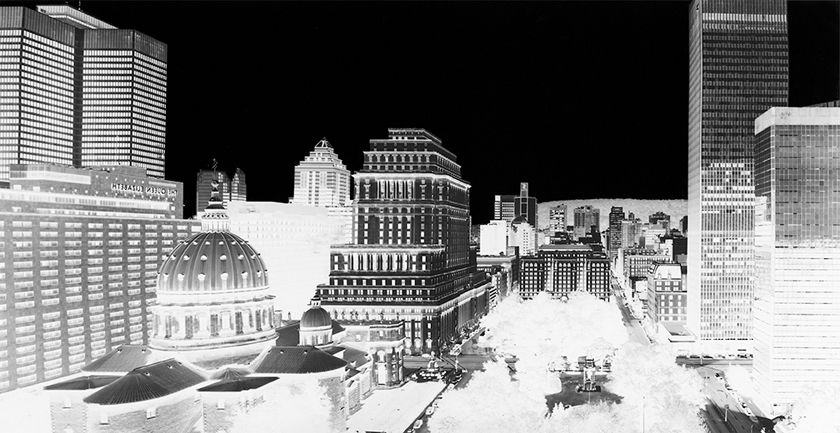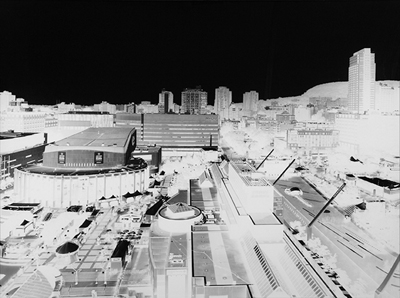
Coin Sainte-Catherine et Jeanne-Mance : Place des festivals, Montréal, 2011
Depuis le 9e étage de l'hôtel Hyatt Regency, rue Jeanne-Mance
-----
Corner St. Catherine and Jeanne Mance: Place des Festivals, Montreal, 2011
From the 9th floor of the Hyatt Regency Hotel, Jeanne Mance Street
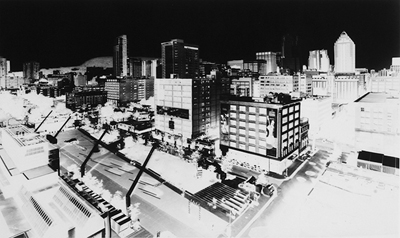
Esplanade de la Place des Arts et Musée d'art contemporain, Montréal, 2011
Depuis le 9e étage de l'hôtel Hyatt Regency, rue Jeanne-Mance
-----
Place des Arts Esplanade and Musée d'art contemporain, Montreal, 2011
From the 9th floor of the Hyatt Regency Hotel, Jeanne Mance Street
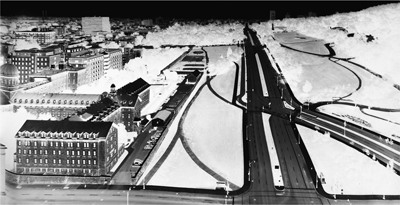
Dytique, Avenue du Parc, Montréal, 2008
Hôpital Hotel-Dieu et le couvent des Hospitalières
-----
Diptych, Parc Avenu, Montreal 2008
Hotel-Dieu hospital and Hospitalières convent
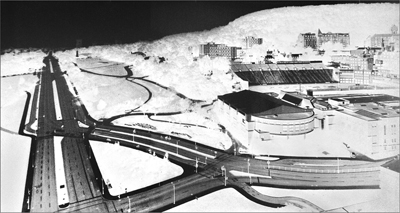
Diptyque, Avenue du Parc, Montréal, 2008
L'hopital Royal-Victoria et le Stade Percival Molson
-----
Diptych, Parc Avenu, Montreal 2008
Royal-Victoria Hospital and Percival Molson Stadium
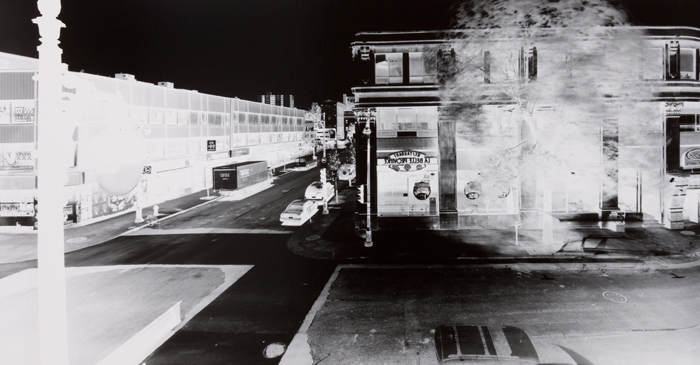
"La belle province" Coin St-Laurent et St-Catherine, Montréal 2006
Depuis le 2e étage de l'Hotel Abri du voyageur, rue St-Catherine
-----
"La belle province" Corner St-Laurent and St-Catherine, Montreal 2006
From the 2nd floor of the Hotel Abri du Voyageur, St-Catherine Street

Maison Shaughnessy, Centre Canadien d'Architecture, Montréal, 2006
Collection Veronica Redgrave
-----
Shaughnessy House, Canadian Centre for Architecture, Montreal, 2006
Collection Veronica Redgrave

Musée d'art contemporain, Montréal, 2004
Vue en anamorphose depuis le 10e étage de l'édifice Wilder, rue Bleury
Collection d'André Cornellier
-----
Musée d'art contemporain, Montreal, 2004
Anamorphic view from the 10th floor of the Wilder Building, Bleury Street
Collection of André Cornellier
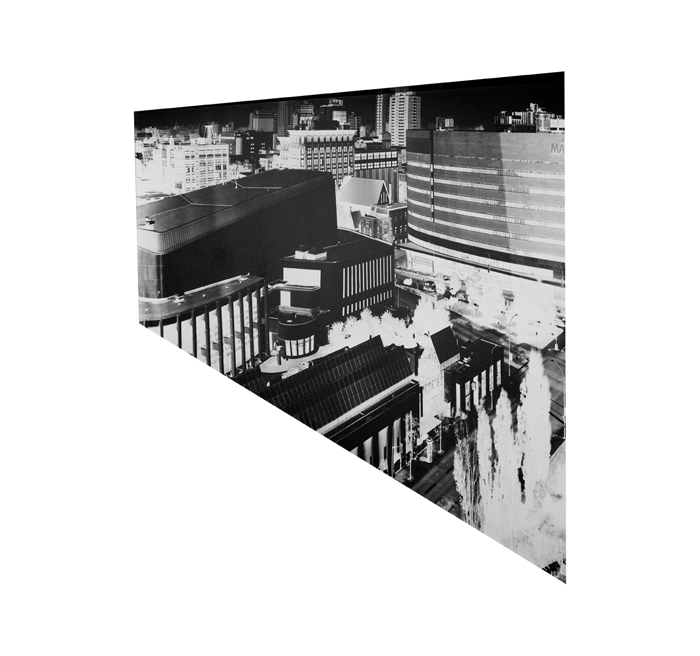
Vue en anamorphose reconstitué
-----
Anamorphic view reconstituted
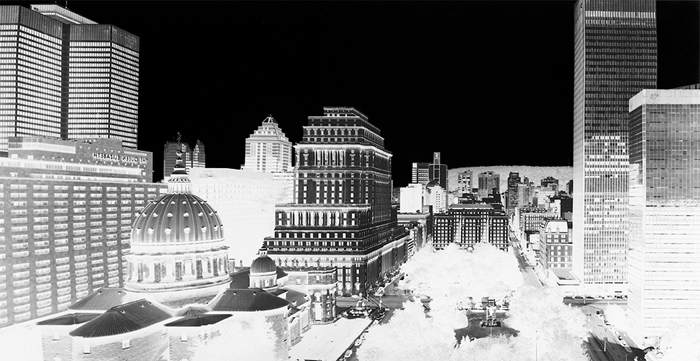
Édifice Sun Life et square Dorchester, Montréal, 2008
Depuis le 15e étage de l'hôtel Marriott Château Champlain, rue De La Gauchetière
-----
Sun Life Building and Dorchester Square, Montreal, 2008
From the 15th floor of the Marriott Château Champlain Hotel, De La Gauchetière Street
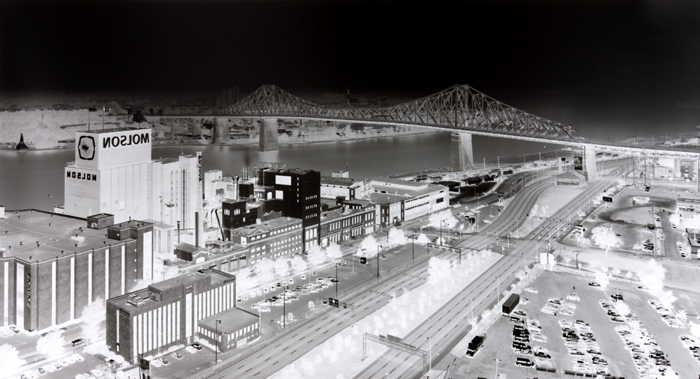
Fleuve Saint-Laurent, pont Jacques-Cartier et brasserie Molson, Montréal, 2005
Depuis le 23e étage de la tour de Radio-Canada, boulevard René-Lévesque
-----
St. Lawrence River, Jacques Cartier Bridge and Molson Brewery, Montreal, 2005
From the 23rd floor of the Radio Canada tower, René Lévesque Boulevard
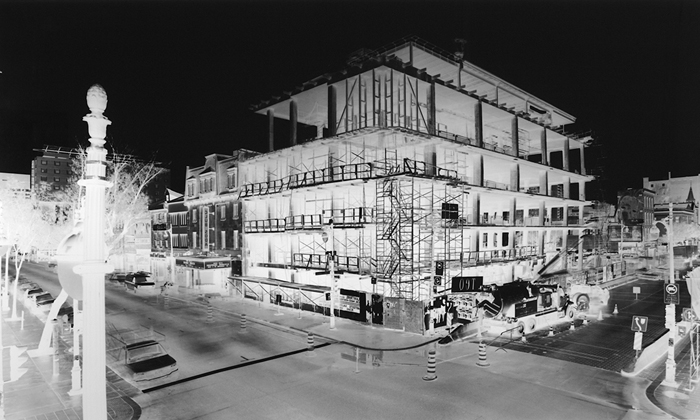
Coin Sainte-Catherine et Saint-Laurent : érection de l'édifice 2-22 Sainte-Catherine, Montréal, 2011
Depuis le 2e étage de l'hôtel Abri du voyageur, rue Sainte-Catherine
-----
Corner St. Catherine and St. Laurent: construction of the 2-22 Ste. Catherine building, Montreal, 2011
From the 2nd floor of the Hôtel Abri du Voyageur, St. Catherine Street
Exposition des oeuvres de
Guy Glorieux — Exhibition of
Guy Glorieux photographs
Guy Glorieux — Exhibition of
Guy Glorieux photographs
Musée McCord
3 février - 27 mai 2012
Exposition réalisée en collaboration avec UMA
Exhibition produced in collaboration with UMA
-----
Montréal en Sténopé
À la fois évidentes et insolites, les vues de Montréal réalisées par Guy Glorieux doivent leur ambiguïté à l'usage d'un appareil au sténopé, du grec stenos (étroit) et opaios (ouverture). Le dispositif rudimentaire renvoie à la camera obscura de Léonard de Vinci: une boîte percée d'un trou d'environ 1,5 mm qui capte les rayons lumineux sur un papier ou un film photosensible placé au fond de la boîte.
Pour réaliser ses photos, Glorieux occupe une pièce à l'étage supérieur d'un édifice, comme la tour de Radio-Canada, qu'il transforme en sténopé géant. Il bouche les fenêtres et tapisse le mur du fond d'un papier photosensible qu'il expose à la lumière de la ville par le trou minuscule. Durant la prise de vue, de trois à quatre heures, Glorieux se trouve dans la pièce et peut intervenir sur l'impression de la lumière pour en modifier les effets. Cette technique produit un tirage unique en négatif et une image inversée comme dans un négatif ordinaire. Afin de rétablir une vue verticale normale, le photographe retourne le tirage.
- Hélène Samson, conservatrice, Musée McCord.
-----
Montreal Through A Pinhole
Familiar yet confusing, the views of Montreal by Guy Glorieux are full of ambiguity. Glorieux created them with a pinhole camera, reminiscent of the camera obscura of Leonado Da Vinci: a box with an aperture of about 1.5 mm, the diameter of a pin, which allows light to pass onto photosensitive paper or film placed at the back of the box.
Glorieux takes most of his images from the upper floor of Montreal building, such as the Radio-Canada tower, transforming an entire room into a giant pinhole camera. He blocks the windows, and lines the back wall of the room with photosensitive paper, and then lets the light of the city come through the pinhole for about three to four hours. During the exposure, Glorieux remains in the room to intervene on the effect of the light on the paper. Developing the photograph produces a single print in negative, as well as upside down and backwards, as on annegative. Glorieux then turns the print right side-up.
- Hélène Samson, Curator, McCord Museum.
-----
Démarche Artistique
J'ai cherché à offrir une perspective différente de la cité qui ferait abstraction du rythme frénétique de ses habitants. J'étais en cela influencé à la fois par les représentations de la cité idéale de Hugh Ferriss et par le travail du photographe Thomas Struth. Le résultat se présente sous la forme d'images où le spectateur peut pratiquement plonger au cœur d'un paysage aux dimensions monumentales. C'est une ville désertique, inquiétante, fantomatique que je présente. Il y règne une nuit sidérale, mais l'intérieur des bâtiments brille comme pour une dernière grande fête. Les habitants semblent êtres partis précipitamment en abandonnant jusqu'à leurs autos. Le temps est suspendu.
- Guy Glorieux
-----
Artist statement
I wanted to offer a different perspective on the city, one that would make abstraction of the frenetic pace of its citizens. In so doing, I was influenced by the representations of the ideal city by Hugh Ferriss and by the work of the German photographer Thomas Struth. The outcome is a series of images where the viewers could almost immerse themselves in a landscape of monumental proportions. It is a barren, disquieting, ghostly city that I present. A city draped in a stellar night, its buildings lit up as if for a final celebration. Its dwellers seem to have fled in great haste, leaving everything behind, even their cars. A city is frozen in time.
- Guy Glorieux
-----
Notes biographiques
Glorieux a exposé au Canada, aux États-Unis et en France. Son travail se retrouve dans les collections d'institutions publiques, dont le Centre Canadien d'Architecture (CCA), UMA, Maison de l'image et de la photographie, Montréal, le Musée Nicéphore Niepce, France, le Musée de la photographie de Charleroi, Belgique, le Musée Hongrois de la photographie, ainsi que dans des collections privées. Il travaille à la promotion de la photographie, notamment au Comité organisateur de la Journée mondiale de la photographie au sténopé.
Courriel : guy.glorieux@gmail.com
-----
Biographical notes
Glorieux has shown work in Canada, the United States and France. His work can be found in the collections of public institutions, such as the Canadian Center for Architecture (CCA), UMA La Maison de l'image et de la photographie, Montreal, the Nicéphore Niepce Museum, France, the Photography Museum of Charleroi, Belgium, the Hungarian Museum of photography as well as in private collections. He actively promotes photography, notably as a founding organizer of the World pinhole photography day.
Email : guy.glorieux@gmail.com
-----
La part de l'ombre.
Dans ses recherches sur le paysage montréalais, Guy Glorieux rejoint le travail d'Eugène Atget à Paris au début du 20e siècle. Mais, alors qu'Atget travaille au niveau de la rue et de ceux qui la peuplent, Glorieux préfère les vues en hauteur d'une ville qui semble vidée de tous ses habitants. La durée même de la prise de vue lui permet d'éliminer le transitoire de l'image pour ne garder que le permanent.
- Robert Hébert, historien de la photographie
-----
Guy Glorieux's work on the Montreal landscape echoes that of Eugene Atget in Paris at the start of the 20th century, but, whereas Atget works at the level of the street and the people that populates it, Glorieux prefers broad perspective on a city that seems empty of it's dwellers. It is the very length of the exposure that permits the photographer removed the transitory from the permanent.
- Robert Hébert, historian of photography
-----
Anamorphose
Dans cette photographie, l'image vue de face, est étirée par une déformation optique déterminé par l'artiste. L'image reprend sa forme quand on la regarde sous l'angle précis d'où la photo a été prise, ici environ 35 degrés. Ce phénomène de transformation visuelle, appelé anamorphose, est connu des peintres et des dessinateurs depuis le 16e siècle.
-----
Anamorphosis
In this photograph, the image seen frontally is intentionally stretched by an optical distortion. It appears undistorted when seen from the precise angle it was potograph in the first place - here about 35 degres. Painters and draftspeople have known about this phenomenon of visual transformation, called anamorphosis, since the 16th century.
-----
Remerciements
UMA, La Maison de l'image et de la photographie, aimerait remercier tous ceux et celles qui ont contribué à la réalisation de la présente exposition Empreinte d'une ville. Montréal en sténopé : particulièrement Guy Glorieux, pour avoir permis à UMA de collaborer depuis 7 ans à la production de ses oeuvres, Suzanne Sauvage et l'équipe du Musée McCord pour la présentation de l'exposition, enfin Bruno Gauthier pour sa générosité.
-----
Acknowledgements
UMA, La Maison de l'image et de la photographie, thanks all those who contributed to Impressions of a City, Montreal Through a Pinhole. In particular, we extend our appreciation to Guy Glorieux, who, for the past 7 years, has invited UMA to collaborate on the production of his work, to Suzanne Sauvage and the McCord Museum team for the presentation of this premier exhibition and finally to Bruno Gautier for is generosity.
-----
et à tous les collaborateurs /
and to all the collaborators:
- Musée McCord
- UMA , La Maison de l'image et de la photographie
- Les Éditions InfoPresse
- Centre de documentation sur la photographie
Textes/Texts : Hélène Samson, Guy Glorieux, Robert Hébert
Reproduction des oeuvres / Artworks reproduction: Marilyn Aitken,
André Cornellier
Graphisme / Graphic design: Philippe Brochard
Impression / Printing: Groupe Laurier
Éditeur / Publisher: André Cornellier pour UMA, La Maison de l'image et
de la photographie
-----

ISBN 978-0-9878709-2-6
© 2012
-----
3 février - 27 mai 2012
Exposition réalisée en collaboration avec UMA
Exhibition produced in collaboration with UMA
-----
Montréal en Sténopé
À la fois évidentes et insolites, les vues de Montréal réalisées par Guy Glorieux doivent leur ambiguïté à l'usage d'un appareil au sténopé, du grec stenos (étroit) et opaios (ouverture). Le dispositif rudimentaire renvoie à la camera obscura de Léonard de Vinci: une boîte percée d'un trou d'environ 1,5 mm qui capte les rayons lumineux sur un papier ou un film photosensible placé au fond de la boîte.
Pour réaliser ses photos, Glorieux occupe une pièce à l'étage supérieur d'un édifice, comme la tour de Radio-Canada, qu'il transforme en sténopé géant. Il bouche les fenêtres et tapisse le mur du fond d'un papier photosensible qu'il expose à la lumière de la ville par le trou minuscule. Durant la prise de vue, de trois à quatre heures, Glorieux se trouve dans la pièce et peut intervenir sur l'impression de la lumière pour en modifier les effets. Cette technique produit un tirage unique en négatif et une image inversée comme dans un négatif ordinaire. Afin de rétablir une vue verticale normale, le photographe retourne le tirage.
- Hélène Samson, conservatrice, Musée McCord.
-----
Montreal Through A Pinhole
Familiar yet confusing, the views of Montreal by Guy Glorieux are full of ambiguity. Glorieux created them with a pinhole camera, reminiscent of the camera obscura of Leonado Da Vinci: a box with an aperture of about 1.5 mm, the diameter of a pin, which allows light to pass onto photosensitive paper or film placed at the back of the box.
Glorieux takes most of his images from the upper floor of Montreal building, such as the Radio-Canada tower, transforming an entire room into a giant pinhole camera. He blocks the windows, and lines the back wall of the room with photosensitive paper, and then lets the light of the city come through the pinhole for about three to four hours. During the exposure, Glorieux remains in the room to intervene on the effect of the light on the paper. Developing the photograph produces a single print in negative, as well as upside down and backwards, as on annegative. Glorieux then turns the print right side-up.
- Hélène Samson, Curator, McCord Museum.
-----
Démarche Artistique
J'ai cherché à offrir une perspective différente de la cité qui ferait abstraction du rythme frénétique de ses habitants. J'étais en cela influencé à la fois par les représentations de la cité idéale de Hugh Ferriss et par le travail du photographe Thomas Struth. Le résultat se présente sous la forme d'images où le spectateur peut pratiquement plonger au cœur d'un paysage aux dimensions monumentales. C'est une ville désertique, inquiétante, fantomatique que je présente. Il y règne une nuit sidérale, mais l'intérieur des bâtiments brille comme pour une dernière grande fête. Les habitants semblent êtres partis précipitamment en abandonnant jusqu'à leurs autos. Le temps est suspendu.
- Guy Glorieux
-----
Artist statement
I wanted to offer a different perspective on the city, one that would make abstraction of the frenetic pace of its citizens. In so doing, I was influenced by the representations of the ideal city by Hugh Ferriss and by the work of the German photographer Thomas Struth. The outcome is a series of images where the viewers could almost immerse themselves in a landscape of monumental proportions. It is a barren, disquieting, ghostly city that I present. A city draped in a stellar night, its buildings lit up as if for a final celebration. Its dwellers seem to have fled in great haste, leaving everything behind, even their cars. A city is frozen in time.
- Guy Glorieux
-----
Notes biographiques
Glorieux a exposé au Canada, aux États-Unis et en France. Son travail se retrouve dans les collections d'institutions publiques, dont le Centre Canadien d'Architecture (CCA), UMA, Maison de l'image et de la photographie, Montréal, le Musée Nicéphore Niepce, France, le Musée de la photographie de Charleroi, Belgique, le Musée Hongrois de la photographie, ainsi que dans des collections privées. Il travaille à la promotion de la photographie, notamment au Comité organisateur de la Journée mondiale de la photographie au sténopé.
Courriel : guy.glorieux@gmail.com
-----
Biographical notes
Glorieux has shown work in Canada, the United States and France. His work can be found in the collections of public institutions, such as the Canadian Center for Architecture (CCA), UMA La Maison de l'image et de la photographie, Montreal, the Nicéphore Niepce Museum, France, the Photography Museum of Charleroi, Belgium, the Hungarian Museum of photography as well as in private collections. He actively promotes photography, notably as a founding organizer of the World pinhole photography day.
Email : guy.glorieux@gmail.com
-----
La part de l'ombre.
Dans ses recherches sur le paysage montréalais, Guy Glorieux rejoint le travail d'Eugène Atget à Paris au début du 20e siècle. Mais, alors qu'Atget travaille au niveau de la rue et de ceux qui la peuplent, Glorieux préfère les vues en hauteur d'une ville qui semble vidée de tous ses habitants. La durée même de la prise de vue lui permet d'éliminer le transitoire de l'image pour ne garder que le permanent.
- Robert Hébert, historien de la photographie
-----
Guy Glorieux's work on the Montreal landscape echoes that of Eugene Atget in Paris at the start of the 20th century, but, whereas Atget works at the level of the street and the people that populates it, Glorieux prefers broad perspective on a city that seems empty of it's dwellers. It is the very length of the exposure that permits the photographer removed the transitory from the permanent.
- Robert Hébert, historian of photography
-----
Anamorphose
Dans cette photographie, l'image vue de face, est étirée par une déformation optique déterminé par l'artiste. L'image reprend sa forme quand on la regarde sous l'angle précis d'où la photo a été prise, ici environ 35 degrés. Ce phénomène de transformation visuelle, appelé anamorphose, est connu des peintres et des dessinateurs depuis le 16e siècle.
-----
Anamorphosis
In this photograph, the image seen frontally is intentionally stretched by an optical distortion. It appears undistorted when seen from the precise angle it was potograph in the first place - here about 35 degres. Painters and draftspeople have known about this phenomenon of visual transformation, called anamorphosis, since the 16th century.
-----
Remerciements
UMA, La Maison de l'image et de la photographie, aimerait remercier tous ceux et celles qui ont contribué à la réalisation de la présente exposition Empreinte d'une ville. Montréal en sténopé : particulièrement Guy Glorieux, pour avoir permis à UMA de collaborer depuis 7 ans à la production de ses oeuvres, Suzanne Sauvage et l'équipe du Musée McCord pour la présentation de l'exposition, enfin Bruno Gauthier pour sa générosité.
-----
Acknowledgements
UMA, La Maison de l'image et de la photographie, thanks all those who contributed to Impressions of a City, Montreal Through a Pinhole. In particular, we extend our appreciation to Guy Glorieux, who, for the past 7 years, has invited UMA to collaborate on the production of his work, to Suzanne Sauvage and the McCord Museum team for the presentation of this premier exhibition and finally to Bruno Gautier for is generosity.
-----
et à tous les collaborateurs /
and to all the collaborators:
- Musée McCord
- UMA , La Maison de l'image et de la photographie
- Les Éditions InfoPresse
- Centre de documentation sur la photographie
Textes/Texts : Hélène Samson, Guy Glorieux, Robert Hébert
Reproduction des oeuvres / Artworks reproduction: Marilyn Aitken,
André Cornellier
Graphisme / Graphic design: Philippe Brochard
Impression / Printing: Groupe Laurier
Éditeur / Publisher: André Cornellier pour UMA, La Maison de l'image et
de la photographie
-----

ISBN 978-0-9878709-2-6
© 2012
-----
